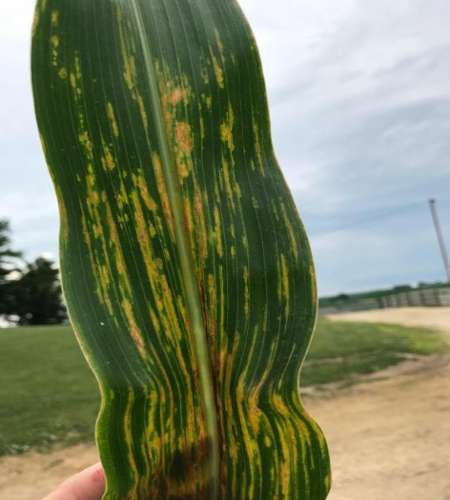By Alison Robertson
Over the weekend there have been several reports of bacterial leaf streak (BLS) of corn in eastern Iowa. The infections also appear to be quite severe (Figure 1).

Figure 1. Symptoms of bacterial leaf streak observed on corn in eastern Iowa in June 2020 (Photo courtesy of N. Stecklein, Bayer).
How do I recognize BLS?
Bacterial leaf streak causes long, thin pale orange to brown streaks on corn leaves. When you hold the leaves up to the light, the streaks “pop” and are surrounded by light yellow halos. Note that BLS can be mistaken for gray leaf spot as well as other diseases and disorders, e.g. fertilizer burn. A publication from the Crop Protection Network discusses the disease and provides helpful tips on diagnosis and distinguishing it from look-alikes.
Why this outbreak in eastern Iowa?
There have been few reports of BLS in Iowa over the past couple of seasons but most have been later in the season. It is possible that heavy precipitation associated with Tropical Storm Cristobal a couple of weeks ago provided the right environment for infection and disease development. It’s possible that some of the hybrids being grown in eastern Iowa are particularly susceptible to the disease. Probably the biggest question I have is where did the inoculum come from? The severity of the disease in the photos I have been sent or seen on Twitter suggests a high inoculum load.
Recent research on BLS
This month’s issue of Phytopathology spotlights recent research on BLS in the U.S. Below are some highlights from the several of the articles:
- Irrigation, crop rotation (multiple years of continuous corn or corn-sorghum rotations), growth stage, tillage, and planting date (on or after 2 May) were associated with BLS.
- Although the bacterium that causes BLS can be detected on seed, the populations are likely not sufficient to result in diseased seedlings.
- Several species of the Poaceae family (e.g. rice, oats, orchard grass, timothy, big bluestem, little bluestem, sand bluestem, green foxtail, bristly foxtail and johnsongrass) and yellow nutsedge developed symptoms of BLS when inoculated in the greenhouse. In the field, symptoms were only observed on big bluestem and bristly foxtail.
- Downy brome, tall fescue and Western wheatgrass were asymptomatic hosts of the BLS bacterium.
Management
There are no in-season management practices for BLS, but proper identification is important to avoid misidentification as a fungal disease and treatment with a fungicide. Most hybrids are susceptible to the disease, although susceptibility may vary among hybrids. The bacterium likely survives in infested corn residue so rotation away from corn for a year or more to allow the residue to decompose. Good weed management is also recommended as some species are alternate hosts for the bacterium.
Source : iastate.edu